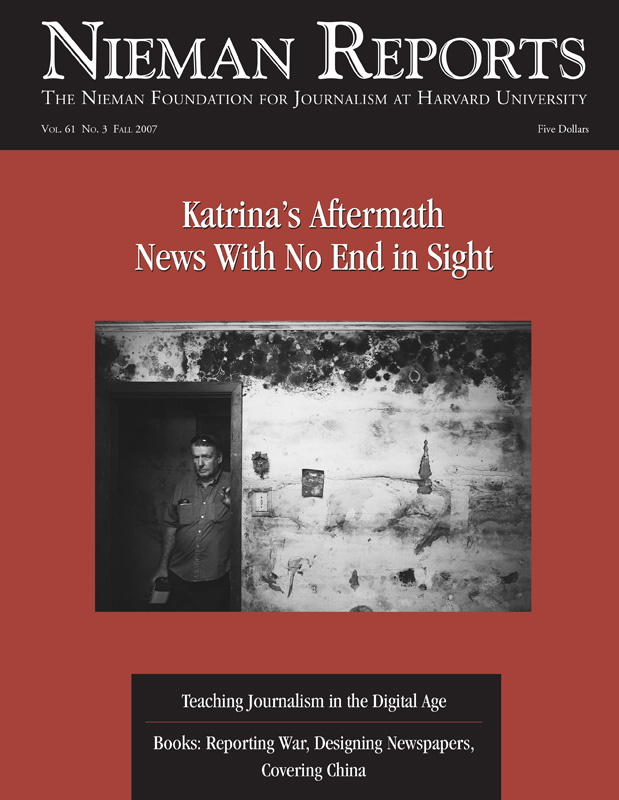The academic year now underway is the first one in which all professional students at Columbia University’s Graduate School of Journalism will have been trained to work on the Internet. Our school was relatively early to embrace the Internet and other new technologies for delivering journalism. We established a New Media major back in 1994. But we treated the Internet as one of several forms of journalism in which a student could specialize. The size of the New Media major waxed and waned with the fortunes of the Internet economy. In my first year as dean, 2003-04, we had only a handful of New Media majors.
Since then a lot has changed. First, jobs that end in “.com” are waxing again and as a result so is our New Media concentration. This year we have 38 New Media majors, by far our largest number ever. Second, and more important, many of our students who major in one of the old media are finding, when they graduate, that they spend much of every day working for their news organization’s Web site.
So we have been making a lot of curriculum changes at the school. We invested in a content management system—something most news organizations have—that permits students and faculty members to post lots of material to their own class-based Web sites, without needing to consult a Webmaster. All faculty who teach our core skills courses are required to be trained to use the content management system, and many other faculty have chosen to be trained as well. Every section of our basic reporting and writing course now operates its own Web site, and every student learns to write for the Web and also to gather images and sound about news stories and post them to the Web. We have hired a small squad of Web experts who go from class to class helping to iron out whatever problems arise in this new regime.
We have also launched this fall three sections of a new class called New Media Newsroom. Here the idea is not to emulate the new life of a newspaper reporter but to experiment with the capabilities of Web journalism in a way that assumes no anchoring presence of another medium. The students experiment with new ways of delivering information, using all of the Web’s rich capabilities for interactivity, linking, and the use of words, sound, and still and moving images. The written “news story”—an 800-or-so-word piece of text meant to be read from beginning to end—is not assumed to be necessarily the basic unit of journalistic production.
It’s amazing to us how quickly and pervasively the Web is permeating nearly everything we do at the school. Quite a few classes other than the ones I just RELATED WEB LINK
The Columbia Journalist
– columbiajournalist.orgmentioned (including the class I teach) operate their own Web sites. On our school’s home page, click on “Student Work” to find an assortment of Web sites that reside in specific classes. We also operate a site called “The Columbia Journalist,” which is a juried selection of some of the best work students in various classes are producing.
Our Columbia Journalism Review now publishes daily on the Web, as well as six times a year in print. The participants in our brand-new Punch Sulzberger News Media Executive Leadership Program—senior executives in news organizations—spend much of their time trying to figure out the economics of journalism on the Web. Another of our new ventures—an initiative to create business school-style case studies about journalism—is developing material that explores the challenges and opportunities that the Web’s ability to efface the line between professional and “citizen” journalists poses to editors and reporters and will also use the Web as a teaching tool for all cases, whether or not they deal substantively with the Web’s impact on journalism. When we teach the history of journalism, we take special care to include material on moments in the past when new communications technologies changed everything.
What makes the Web so attractive to us is that the barriers to entry are so low. As much as we groan at budget time over how heavily we are investing in technology, we can afford to get ourselves much closer to professional levels of production on the Web than we can in the print or broadcast media. The Web has the greatest inherent capability of any journalistic medium we use at the school and the lowest production and distribution cost. And, although we are interested in the economic challenges the Web poses to news organizations, so far it has not been a “disruptive technology” in the economic sense for graduate schools at research universities. For us, the Web is entirely positive: It is a journalistic tool with wondrous powers, and to the extent that its advent requires a rethinking of journalism’s professional norms, well, what better place for that than a journalism school?
Nicholas Lemann is dean of the Graduate School of Journalism at Columbia University and serves as its Henry R. Luce Professor.


